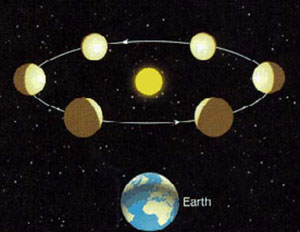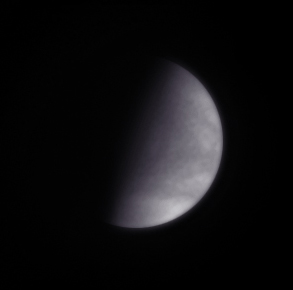If you’ve been outside after sunset the past few weeks, there’s not much chance you’ve missed Venus shining like a laser in the west. It’s obvious enough anyway, but the conjunction (close pass) of Jupiter really made this a sight to see!
 And as lovely as it is to look at with the eye, Venus is starting to get interesting through a telescope now as well. Venus has phases, just like Moon. It orbits closer to the Sun than we do, so sometimes we see it on the far side of the Sun, and sometimes it’s between us and the Sun. When it’s on the other side of the Sun we see it fully illuminated, and as it gets between us and the Sun it appears as an ever-thinner crescent. Hopefully the diagram here will help (click to embiggen).
And as lovely as it is to look at with the eye, Venus is starting to get interesting through a telescope now as well. Venus has phases, just like Moon. It orbits closer to the Sun than we do, so sometimes we see it on the far side of the Sun, and sometimes it’s between us and the Sun. When it’s on the other side of the Sun we see it fully illuminated, and as it gets between us and the Sun it appears as an ever-thinner crescent. Hopefully the diagram here will help (click to embiggen).
Right now, Venus is just “rounding the corner” of its orbit; the past few weeks it’s been heading away from the Sun from our viewpoint, and very soon will reach its greatest elongation in the sky from the Sun. At that point, every day will see Venus get a bit closer. Right now, Venus is very close to being half full. “Amateur” astronomer Emil Kraaikamp observed Venus on March 15, and took this very nice shot of it:
Venus is shrouded in clouds, making it relatively featureless when you look at it through a telescope. However, if you use a filter that lets in ultraviolet light, some faint and subtle features in the clouds can be seen. Emil’s picture did just that, using a UV filter plus one each of red, green, and blue to get a true color plus UV picture. The phase of the planet is obvious enough, and you can also spot some of the patterns to the clouds, too.
 Another astrophotographer, Alan Friedman, also took a stab at Venus (this time on March 17) and got the picture shown inset here. Again, you can see some detail, but clearly it’s not easy to get the goddess of love to reveal her secrets!
Another astrophotographer, Alan Friedman, also took a stab at Venus (this time on March 17) and got the picture shown inset here. Again, you can see some detail, but clearly it’s not easy to get the goddess of love to reveal her secrets!
Venus reaches its maximum distance from the Sun in our skies on March 27. After that it starts moving closer to the Sun. It’s not physically getting closer to the Sun, it’s just moving between us and the Sun, but to us when we look at it in the sky we’ll see the two getting closer together.
But in physical fact Venus is getting closer to Earth, so even as it becomes a thinner crescent it will be getting bigger and bigger as our distance narrows, making it a great target even for binoculars. This means it will be getting even brighter in our sky! So if you think it looks like a beacon glowing to the west now, just wait a few weeks.
… and then the most amazing thing will happen: Venus will pass directly across the face of the Sun! This is an incredibly rare event. These transits, as they’re called, occur in pair separated by 8 years, but each pair is separated by more than a century. The last one was in 2004, but the next won’t be until December of 2117!
I’ll have more info about this event soon. The transit happens on June 5/6 2012, so you might want to make space in your calendar. Odds are pretty good this will be your only chance to ever see it again.
Image credits: Emil Kraaikamp; Alan Friedman, used by permission
Related Posts:
- Galactic arch over the conjunction
- Paradise above and below
- Pic of pairs of planets and people
- Juspiter and Venus still blaze in the west